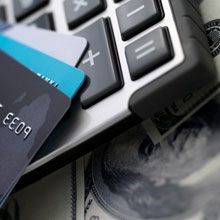Article by Investment U

Dwolla may well be one of the biggest “disruptors” on the financial services scene today.
Here is a bit of financial trivia. In the 116-year history of the Dow Jones Industrial Average, which component stock was the first (and only) to go into corporate liquidation?
Does the name “U.S. Leather” ring a bell?
In 1896, when the DJIA was put together, U.S. Leather carried a market cap of $2 billion (in today’s dollars). From boots to bookbindings, belts and buggy whips – leather was as much a key ingredient of the fast-growing national economy as steel or coal. Manufacturers had no other choice if they needed a material that was tough, durable and flexible.
All that changed in the twentieth century’s first decade. Autos began to displace horses as means of transportation. The first rubber-soled shoes hit the market, and so did the first pneumatic rubber tires. Rayon, the first manmade fiber, went into mass production in 1905.
U.S. Leather’s monopoly position and profits disappeared. By 1920, the keepers of the DJIA booted the company out of the index.
So here’s what I’m wondering… Is the protected, insular world of big banks about to go the same way as U.S. Leather?
Here’s what got me thinking about the analogy. One word: Dwolla.
Financial “Disruptor”
Dwolla.com is a new, but fast growing payments processing company based in Des Moines, Iowa.
If you (and a merchant) have both registered with Dwolla and downloaded the company’s smartphone app, you can buy goods and services, just like any card-based transaction. And like a debit card, Dwolla is tied into your bank account. If you buy a cup of java at a coffeehouse, Dwolla debits your account, and credits the merchant’s (at near instant response times). Simple enough.
But that doesn’t explain Dwolla’s huge growth since it opened its doors a little over two years ago. Back then, it was processing a tiny $200,000 in transactions a month. A year later, that figure grew to $4 million, and now – $30 to $50 million a month.
Here is why Dwolla may well be one of the biggest “disruptors” on the financial scene today. To use Dwolla costs:
- $0.25 for any transaction costing $10 and up (to a maximum of $5,000).
- For transactions under $10, there is no cost at all, to you or the merchant. There’s nothing pre-paid, no setup fees, no annual fees, and no account maintenance costs. Nada.
How can that be? Especially when banks charge (or try to charge) monthly debit card fees against your account, and per use “swipe fees,” not to mention ATM withdrawal fees (now averaging $2.40 per transaction) whenever you use a machine not belonging to your own bank?
Dwolla took one very important, extra step when it set up its business: it built its own secure, proprietary, all-digital, payments network. And by doing so, Dwolla sidestepped the biggest cost to consumers and merchants everywhere: interchange fees.
The “Squishy Center” of Banking Profits
Think of an interchange fee as a toll (roughly 1.1% to 2%) added to every transaction that’s processed on the nation’s electronic payments superhighway. Every time you buy something with your debit or credit card, the credit card companies like Visa and Mastercard add a little extra to the bill. Click here to read Visa’s recent PDF outlining its latest interchange fees. Those fees, duly collected, are sent on to whatever bank issued the credit or debit card to you.
For banks, those interchange fees add up… big. Consider that in 2010 alone…
- Merchants paid $28 billion in total interchange fees to banks (estimated by the Cardhub.com website).
- JPMorgan Chase (NYSE: JPM) collected $5.9 billion (5% of total revenue) in non-interest credit card income – the bulk of it from interchange fees.
- Bank of America (NYSE: BAC) brought in $8.1 billion (or 7% of total revenue) through similar means.
- Even a mid-size bank like Regions Financial (NYSE: RF) collected non-interest card income of almost $1.1 billion (again, mostly through interchange fees), representing 18% of its revenue base.
The irony is that, in 2011, and this year as well, bank income from interchange fees is on the decline anyway, because of new federal rules (the Durbin amendment). Wells Fargo, for instance, saw its interchange fee revenue drop by $611 million, or 36%, simply because of the rate caps.
But Dwolla’s appearance on the scene could finish the job, and do the same thing to large banks that eBay and Craigslist did to newspapers, what Netflix did to Blockbuster, what Apple and Amazon are doing to book publishers right now: Gut out the “squishy center” of their jelly donut full of profits.
Here’s one example: Rick Vosper, an executive in the bicycle retail sector (and a fan of Dwolla) estimated that if half the nation’s 3,000 specialty retail bike shops (and their customers) used Dwolla (instead of credit cards) for purchases, it would result in $67 million less in interchange fees going to the banks. That’s just one small industry. What happens when Starbucks or another retail heavy-hitter embraces Dwolla?
For now, Dwolla is still small. Its user base of consumers and merchants is still in the hundreds of thousands. But the company is growing fast – it just picked up another round of VC financing (TV star Ashton Kutcher among those investors) in February. And the company’s growth in leaps and bounds has the payments-processing industry watching carefully (especially those potential relics of twenty-first century finance… the big banks).
Good Investing,
Jeff Yastine
Article by Investment U